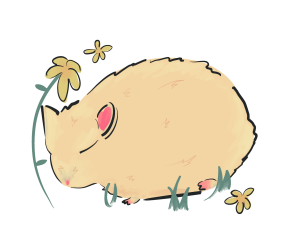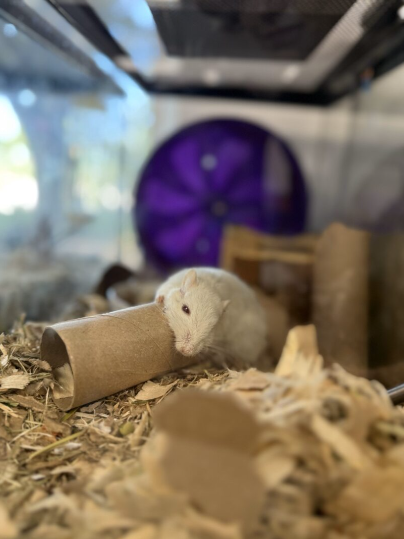
ASH PETRIE
Adenine, the oldest gerbil of the colony, chewing on a donated roll of toilet paper.
A spontaneous summer romance between the gerbils housed on South Campus led their population to double,
overwhelming the biology lab.
“The males and females are supposed to be separate, but then we discovered the babies,” said South associate biology professor Paul Luyster. “There was one male, and he was having a great time.”
Sitting in the hallway outside Luyster’s office is a huge case with bright yellow letters spelling out “La Maison de Rodentia,” which translates to The House of Rodent.
This mansion, Luyster said, is where the gerbils live, go to gerbil school, attend gerbil discos and play in the gerbil pit, but mostly they just huddle together in the corner of their gerbil dorm.
Student workers for the biology lab care for the small creatures, and one of their tasks is to thoroughly clean their decorated enclosure. To do this, they must remove the colony and ensure they’re separated by sex when going back in, which can be difficult.
“Sometimes students accidentally put the wrong gerbil in the wrong section,” Luyster said. “We did name them all, but it is hard to tell some of them apart.”
Over the course of summer break, one misplaced male gerbil named Lucky got lucky with at least two females. Luyster said they know one mother is Blinky, but the other could be either Guanine or Cysteine, sister gerbils named after two of the four nitrogen bases of DNA.
“We were trying to keep our population limited,” Luyster said. “We pulled him out and put him back with the other males, and he’s fine, but we do have a large population now because of that little mistake.”
Edgar Rodriguez Perez, a student worker in the lab, cares for the gerbils. He said the tunnelling experts construct networks all throughout the encloser with chewed-up bits of recycled cardboard.
“I used to call the gerbils beavers,” Perez said. “They chew everything apart like how beavers chew up wood.”
The department has a donation box next to the lab for students and faculty to donate their old paper towel and toilet paper rolls to the gerbils.
“I’ve watched these two make four toilet paper rolls into mulch in less than one hour,” Perez said while pointing to Adenine and Thymine, male gerbils named after the other two nitrogen bases of DNA.
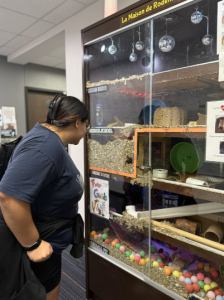
Student Carmen Gomez said she has visited the gerbils for a while now and routinely walks through the biology building to see them.
“I have a math class across from the architecture building, and it’s just really cute to pass by them because they’re really adorable,” Gomez said.
She is an avid toilet paper donator, too.
“Since I have a huge family, we always go through that. So we’ll bring some for them,” Gomez said. “It’s really nice and they’re my little serotonin boost throughout the day.”
While the gerbils are well known to those on campus, they’re just one of the many species living in the biology lab.
What started out as a small student donation of two gerbils, some fish and a frog a few years ago has turned into an exhibit.
“Recently, we got a chinchilla, so now we now have quite a zoo,” Luyster said.
Once other people realized they could donate animals to the lab, they were given two guinea pigs named Peanut Butter and Jelly, a bearded dragon named Rango and a turtle named Captain.
“These were all given to us by people who needed a home for them, and so we’ve taken them in, and we give them really good care,” Luyster said.
While they’ve been donated many animals, the biology department has more than just four-legged creatures calling their lab home. Along the back wall of the classroom are shelves storing plastic bins with Madagascar hissing cockroaches and dermestid beetles inside.
Luyster teaches an undergraduate research program for biology, allowing students to pick a project to work on during the semester. A few years ago, one student wanted to study the cockroaches’ behavior.
“We’ve kept the population going ever since,” Luyster said. “I’ve written a lab that uses them, and now students observe their behavior and their mating rituals because they have their own little dances they do. So we use them for lab. We don’t kill them. We just observe them.”
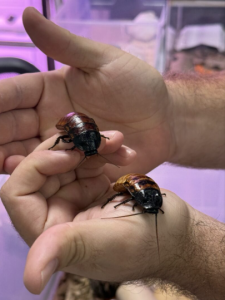
The dermestid beetles were added for a student wanting to study taxidermy. They’re flesh-eating insects she wanted to use to clean bones. The lab has kept their population going as well and now has a freezer set at -80 degrees Celsius to house any roadkill or any carcasses donated to their program.
“We have a lot of birds that run into windows on our campus,” Luyster said. “Whenever faculty see that, they tend to call me up and say, ‘Hey, you want the bird?’ and I’ll send my student workers over to collect the bird and bring it back and give it to our beetles.”
Perez said he works on many projects with the dermestid beetles and is currently having them decompose a shark’s jaw donated to use for a shadow box.
“Luyster said he is going to make me a shirt with a bug on it,” Perez said while allowing cockroaches to crawl across his hands.
Luyster said he incorporates the animals and insects into his biology classes by either creating labs specific to the species or by just having them around for students to observe their personalities.
“They’re actually very vocal, particularly the guinea pigs. If you come in and make a noise that sounds like you’re opening a package of food, they’ll start squealing at you,” Luyster said. “And you would not expect a turtle to be fast, but he is the most likely of all our animals to disappear running down the hall.”
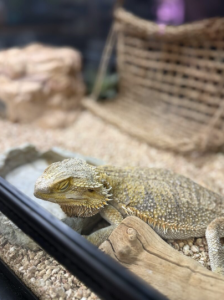
Petra, their bearded dragon, is the most temperamental of all the animals in the lab, according to Perez.
“We call it ‘being Petra’ because she’s so sassy,” Perez said. “She’ll only drink water when we give her a bath, and she only eats when you hold food up to her mouth.”
Many students tell Luyster they look forward to their biology class, and he said he’s seen how the animal’s presence curates a positive and engaging environment for them to learn.
“I think for the students, it gives them something to get excited about,” he said. “A lot of them are enthusiastic about seeing the animals, and they want to hold them and pet them.”
For Luyster, he said he just loves spending time there.
“That’s my Zen space. I tell people, when you get depressed or stressed out, come hang out with our animals,” he said. “There are therapy dogs, but here you can have a therapy guinea pig.”
